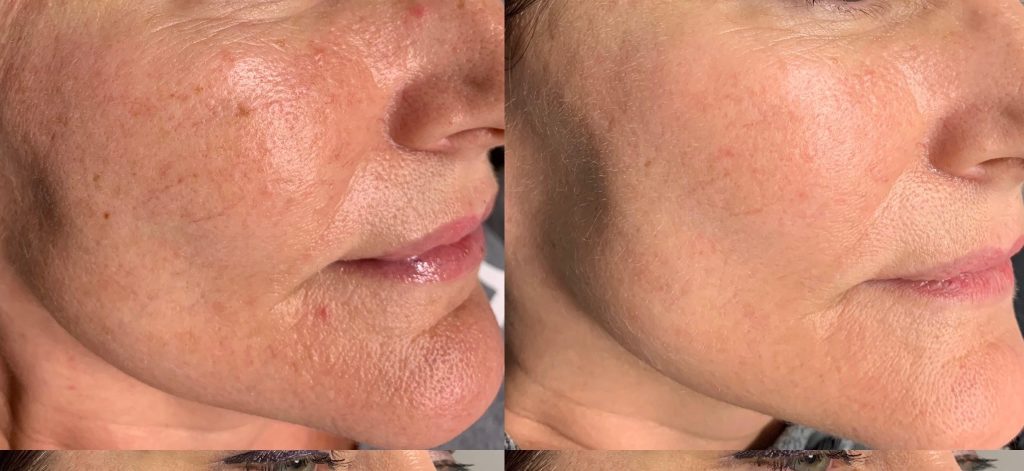
Transform your skin with our trio of advanced treatments: IPL, microneedling, and photodynamic therapy. IPL (Intense Pulsed Light) targets and reduces pigmentation and redness for a clearer complexion, while microneedling stimulates collagen production to smooth and rejuvenate your skin. Photodynamic therapy uses light-activated solutions to treat acne and sun damage, delivering a radiant, flawless glow that enhances your natural beauty.
Microneedling
Stimulates new elastin and collagen production in your face and neck
Collagen induction therapy, also known as microneedling, creates hundreds of tiny wounds in the top layer of skin using fine needles. This treatment successfully helps repair skin from the effects of aging, as well as pigment issues, sun damage, and acne scars.
What is microneedling?
Microneedling is a minimally-invasive treatment that delivers tiny punctures to the skin using micro-fine needles. This causes healing to take place in the skin and stimulates the production of new collagen and elastin.
What does microneedling treat?
- Repairs visible scars
- Reverses sun damage and pigmentation issues
- Reduces fine lines and wrinkles
- Tightens skin
What should I expect after my microneedling treatment?
Prior to the treatment, numbing cream will be applied to minimize the slight pain that is felt during the procedure. After the treatment you will have some inflammation, however this will be temporary and will subside greatly within several hours. Mild swelling reduces over one day. Your skin may remain a little red for two days after the treatment. The inflammation and swelling can be soothed with topical creams applied after the procedure.
Using hyaluronic acid after the procedure can help reduce inflammation. Sunscreen should always be used to protect the skin. A good mineral makeup, such as glominerals™ is an excellent makeup to use after the treatment.
How many treatments are recommended and what results should I see?
Three treatments are recommended for increasing collagen and elastin production. However, you will see improvement after only one treatment. Scar reduction may require more than three treatments.
After the treatment, your skin begins to heal itself immediately, producing new collagen that stays active for approximately a year. This new collagen and increased elastin production will provide you with younger, healthier, and firmer-looking skin.
You will notice fewer wrinkles, fine lines, and a reduction in acne scars. Most of all you will experience better overall tone and texture in your skin.
IPL (Intense Pulsed Light) – Cutera® Limelight
Skin redness, brown spots, and sun damage treatment.
The Intense Pulse Light (IPL) seeks out and safely destroys red and brown abnormal pigmentation at the skin surface. We utilize a state-of-the-art, real time individual pulse-calibrated light source technology to accurately and safely treat you without the risk of under or overexposure.
What does IPL treat?
- Any part of your face, neck, chest, arms, hands
- Skin redness
- Telangiectasia (tiny veins)
- Discoloration and uneven pigmentation
- Brown spots and age spots
What does the treatment do?
We will customize your treatment to your skin type and treat the brown and/or red pigmented areas on your skin. It’s the heating of the pigmented brown or red cells that causes the therapeutic effect.
What do treatments feel like?
When the pulse of light is delivered, patients will experience a mild pinching or stinging sensation. Anesthesia or pain medicine is typically not required.
How long will the treatments take and how many treatments will I need?
Treatment time depends on the area of the body being treated. However, most treatments should take less than one hour. Two to four treatments are usually sufficient to see results.
What happens after the treatment?
Immediately following treatment, brown spots will start to darken and your skin may appear slightly red. Make-up can be applied to cover the redness.
When will I see results?
Within one to three weeks, the darkened spots will flake off and fade. Diffused redness or telangiectasia will decrease and your mottled complexion will improve.
Photodynamic Therapy
Mild to severe acne, appearance of acne scars, and sun damage.
Photodynamic therapy (PDT) is a non-invasive method of treating common facial skin conditions, such as age spots, rosacea, and acne. By combining a photosensitizing solution called Levulan® and a light source system, photodynamic therapy targets specific skin cells while leaving surrounding tissue unharmed.
What is Photodynamic Therapy used for?
Photodynamic therapy was originally used to treat pre-cancerous lesions. Later, it was used for rosacea, facial wrinkles, sun damage, and age spots. The most recent and innovative treatment is Photodynamic acne therapy, which is becoming a great alternative to medications such as Accutane® for the treatment of mild to moderate acne.
How does PDT work?
A photosensitizer agent is applied to the skin and is absorbed into sebaceous glands. It is then activated by a blue-light is used for 8-12 minutes, which leads to shrinkage of these glands. This results in significant improvement in moderate to severe cystic acne.
Is PDT uncomfortable?
During the PDT treatment, the skin is washed several times and the photosensitizer agent is applied, which may cause a slight stinging sensation. You may have some itching and a mild sunburn feeling immediately following the treatment.
What can I expect for the first week following treatment?
The skin will be extremely red and slightly swollen (most likely around the eyes). This will subside in 3-7 days following the treatment. Applications of ice or cold packs will help. After about 48-72 hours the top layer of your skin will scale, flake, and peel off.
Sun exposure must be avoided for the week following the treatment. You will be given post care instructions and products to help minimize these effects.
What are some side effects?
Although allergic reactions are rare, some patients may experience an allergic reaction to the active agent. Before undergoing photodynamic therapy, we will discuss the side effects, risks, and benefits with you.

